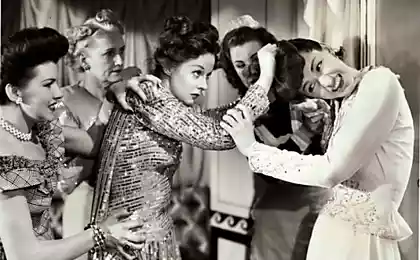1266
Women's duel
XVI century. It was at this time the first reliable data on women's duels. And they, by the way, dispel the myth that the pioneers in this case were French. So, in the chronicle of Milanese convent Sv.Benedikty mentioned that May 27, 1571 the monastery came two notable senorita. They asked permission to abbess room for a joint prayer. Permission was granted. But locked in the room, senorita instead start praying, drew daggers and rushed at each other. When the noise frightened nun burst into the room, opened it in front of them horrifying picture: on the floor were two bloody ladies, one of whom was dead and the other dying.
In the XVII century a French officer willfully lived in the house of the Countess de San Belmont, young beauties widow. The countess sent him a polite note asking her to explain the invasion, but it was ignored. Then she sent the officer challenge to a duel, to sign a "Chevalier de Saint-Belmont." The officer accepted the challenge and, appearing at the appointed place, met Madame, which has been carefully disguised in men's clothing. As uncommon beauty dressed had a sword, then a few minutes later, she fights a sharp intake knocked the weapon from the hands of the enemy, throwing blade foot, approached the officer with the words that made him blush with shame, "you think, Monsieur, that fought with the Chevalier . You are mistaken - I Madame de San Belmont. And I urge you in the future to be more responsive to women's requests ".
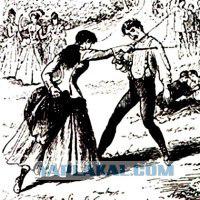
When once backstage Opera to it with incorrect joke went Dyumeni actor, rude and arrogant man, in response to some of his self-righteous phrases she challenged him to a duel. Not expecting such a turn Dyumeni stared at her and laughed. Then the singer, snatched from passing near the theater prop sword, whip her abuser, and then took away his watches and snuffbox as a sign of his victory. After this incident, the girl's life changed radically. She decided to anyone and never allow themselves to insult. The case to prove their integrity to report to it soon enough. One of the balls is one of those present had offended her. After receiving a challenge to a duel, he was surprised as well as Dyumeni and refused to fight. Then the singer asked him publicly to publicly ask for forgiveness.

In June of 1829 in the Oryol province duel with sabers, over the death of the opponents. It would seem that in this special, Russian duels surprise. But that time has not crossed their arms men and women, landowner Olga Zavarov and Yekaterina Polesov who have chosen this method to resolve a trivial quarrel. The story had a continuation. After 5 years, the duel between their grown up daughters, resulted in the death of Anna Polesov. Ironically, women's duel in Russia and Europe were not uncommon. Russia was considered exotic for the duel between man and woman, although the enlightened Europe, such fights were the order of things.
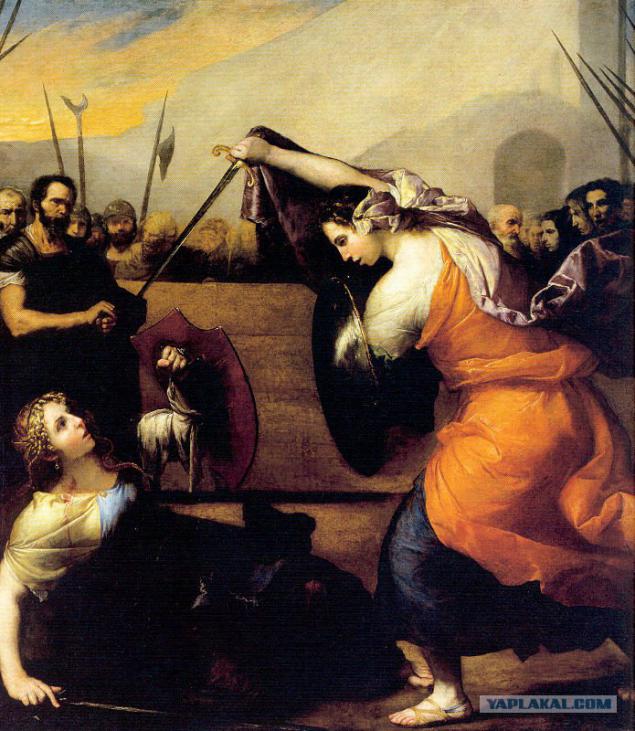
In Russia, women's fights existed since ancient times. At the end of the XIV century Pskov court charter states that in the case of judicial duel between man and woman, possibly on behalf of a relative or exhibiting poedinschitsy hireling. But between a woman have to fight alone.
In the XVIII century Peter I banned the fights, which is then confirmed by almost all the emperors. But duels from this does not become less.
It is curious that in a fight, even had time to participate the future Empress Catherine II, who, as a princess in June 1744 fought with swords second cousin Princess Anne Ludwig Anhalt. Duelyantkam was only 15 years old, and the match, fortunately, ended without bloodshed.
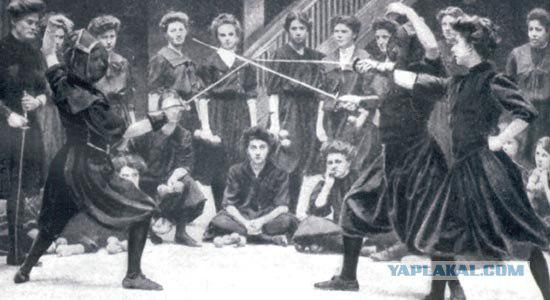
Perhaps in memory of this event the Empress looked at women's duel through his fingers, only that they did not end with death or serious injury. It is believed that during the reign of Empress only three female duel ended in death. Many Russian ladies well owned weapons and were not averse with his help clarify the relationship. The publications have repeatedly seen mention that only in 1765 among the ladies was 20 duels, 8 of which as sekundantki participated Empress. Recently (part of Catherine), frankly, hard to believe.
The most famous duel of the time with the Russians became a duel that took place in 1770 between the Princess and Duchess Catherine Dashkova Fokson. It took place, however, it is not in Russia and in London. In the house of the Countess Pushkinoj two women's education in Europe peacefully talking. Gradually, the conversation turned into a debate, and then heated argument ended mutual slaps and a challenge to a duel. Ladies could not reconcile and fight with swords, which occurred here in the garden, he ended Dashkovoj wound in the shoulder.
If men have traditionally fought in nature, preferring to guns, the Russians take their own swords without leaving home. There were even secular salons that were famous ladies just fights. For example, in the cabin of Mrs. Vostrouhovoy, according to gossip, only in 1823 was 17 female duels
Interesting notes about fights Russians left the French Marquis de Morten: "Russian ladies love to sort things out between themselves with weapons. Their duel do not carry no grace that can be seen in French women, but only blind rage aimed at the destruction of the opponent. " Perhaps with the more obvious, the more so in her native France in that period women fought naked to the waist, which looked probably really elegant. And about the "blind rage" leave on her conscience, in fact fatal duels Russian women were extremely rare.

It is interesting that Russian literature and painting female duel bypass silence, while in Europe they dedicate the novels and paintings. The most famous was the painting "Women's duel", created the Spaniard José de Rivera in 1636. It happens in Spain can see it in the Madrid gallery "Prado." The very duel took place long before the creation of the painting. In 1552, Isabel de Neapolitan Karatstsi and Diambra de Pettinella, claim to love the young rake Fabio de Zeresola, we decided to find out by relations duel with swords. Neapolitan swords were slightly heavier than the sword, and many ladies skillfully mastered. While the ladies fight was exotic, so the rumor of it is preserved for a long time, prompting the artist to the plot of the picture.
At the time of writing, painting Europeans already hard to sort things out with weapons in hand. Live artist in France, he would probably have chosen a different story - a duel Marquise de Nesle and Madame de Polignac, occurred in the autumn of 1624. The peculiarity of this duel was that women were fighting for Cardinal Richelieu, who had just received the post of first minister of the king. Perhaps holiness Cardinal himself is not particularly bothered, as the result of a duel clearly theological disputes. Although women have chosen to clarify the relationship pistols, duel ended with little bloodshed - Countess slightly wounded opponent in the shoulder. But apparently, this fight amuse vanity Cardinal that he even mentioned it in his notes. But the details of this piquant story long relished in the aristocratic circles of Paris. Ladies so accustomed to arms, even posed for artists with swords in their hands. The paintings of Jean Beraud elegant French holding swords so at ease, as if the weapon is a common accessory ladies' attire, such as a fan or an umbrella.
Some ladies to the extent mastered the art of fencing, which began to provoke the men's fights. The most famous was Mademoiselle de Maupin, who had spent several successful duels with men. Her real adventures based his novel "Mademoiselle de Maupin" the writer Theophile Gautier. The novel is written fascinating and worth it to read it. Today describe the female fights in the media is not uncommon, but the vast majority are ordinary domestic fights and stabbing, which have nothing to do with the duels.
Dobavleno1 in [mergetime] 1259248848 [/ mergetime]
everything seems to be
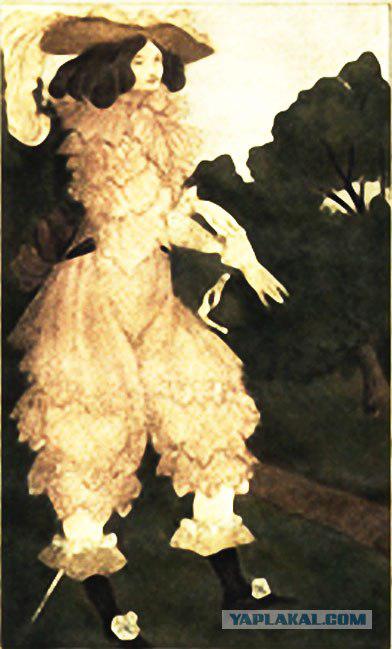
Source:
In the XVII century a French officer willfully lived in the house of the Countess de San Belmont, young beauties widow. The countess sent him a polite note asking her to explain the invasion, but it was ignored. Then she sent the officer challenge to a duel, to sign a "Chevalier de Saint-Belmont." The officer accepted the challenge and, appearing at the appointed place, met Madame, which has been carefully disguised in men's clothing. As uncommon beauty dressed had a sword, then a few minutes later, she fights a sharp intake knocked the weapon from the hands of the enemy, throwing blade foot, approached the officer with the words that made him blush with shame, "you think, Monsieur, that fought with the Chevalier . You are mistaken - I Madame de San Belmont. And I urge you in the future to be more responsive to women's requests ".

When once backstage Opera to it with incorrect joke went Dyumeni actor, rude and arrogant man, in response to some of his self-righteous phrases she challenged him to a duel. Not expecting such a turn Dyumeni stared at her and laughed. Then the singer, snatched from passing near the theater prop sword, whip her abuser, and then took away his watches and snuffbox as a sign of his victory. After this incident, the girl's life changed radically. She decided to anyone and never allow themselves to insult. The case to prove their integrity to report to it soon enough. One of the balls is one of those present had offended her. After receiving a challenge to a duel, he was surprised as well as Dyumeni and refused to fight. Then the singer asked him publicly to publicly ask for forgiveness.

In June of 1829 in the Oryol province duel with sabers, over the death of the opponents. It would seem that in this special, Russian duels surprise. But that time has not crossed their arms men and women, landowner Olga Zavarov and Yekaterina Polesov who have chosen this method to resolve a trivial quarrel. The story had a continuation. After 5 years, the duel between their grown up daughters, resulted in the death of Anna Polesov. Ironically, women's duel in Russia and Europe were not uncommon. Russia was considered exotic for the duel between man and woman, although the enlightened Europe, such fights were the order of things.

In Russia, women's fights existed since ancient times. At the end of the XIV century Pskov court charter states that in the case of judicial duel between man and woman, possibly on behalf of a relative or exhibiting poedinschitsy hireling. But between a woman have to fight alone.
In the XVIII century Peter I banned the fights, which is then confirmed by almost all the emperors. But duels from this does not become less.
It is curious that in a fight, even had time to participate the future Empress Catherine II, who, as a princess in June 1744 fought with swords second cousin Princess Anne Ludwig Anhalt. Duelyantkam was only 15 years old, and the match, fortunately, ended without bloodshed.

Perhaps in memory of this event the Empress looked at women's duel through his fingers, only that they did not end with death or serious injury. It is believed that during the reign of Empress only three female duel ended in death. Many Russian ladies well owned weapons and were not averse with his help clarify the relationship. The publications have repeatedly seen mention that only in 1765 among the ladies was 20 duels, 8 of which as sekundantki participated Empress. Recently (part of Catherine), frankly, hard to believe.
The most famous duel of the time with the Russians became a duel that took place in 1770 between the Princess and Duchess Catherine Dashkova Fokson. It took place, however, it is not in Russia and in London. In the house of the Countess Pushkinoj two women's education in Europe peacefully talking. Gradually, the conversation turned into a debate, and then heated argument ended mutual slaps and a challenge to a duel. Ladies could not reconcile and fight with swords, which occurred here in the garden, he ended Dashkovoj wound in the shoulder.
If men have traditionally fought in nature, preferring to guns, the Russians take their own swords without leaving home. There were even secular salons that were famous ladies just fights. For example, in the cabin of Mrs. Vostrouhovoy, according to gossip, only in 1823 was 17 female duels
Interesting notes about fights Russians left the French Marquis de Morten: "Russian ladies love to sort things out between themselves with weapons. Their duel do not carry no grace that can be seen in French women, but only blind rage aimed at the destruction of the opponent. " Perhaps with the more obvious, the more so in her native France in that period women fought naked to the waist, which looked probably really elegant. And about the "blind rage" leave on her conscience, in fact fatal duels Russian women were extremely rare.

It is interesting that Russian literature and painting female duel bypass silence, while in Europe they dedicate the novels and paintings. The most famous was the painting "Women's duel", created the Spaniard José de Rivera in 1636. It happens in Spain can see it in the Madrid gallery "Prado." The very duel took place long before the creation of the painting. In 1552, Isabel de Neapolitan Karatstsi and Diambra de Pettinella, claim to love the young rake Fabio de Zeresola, we decided to find out by relations duel with swords. Neapolitan swords were slightly heavier than the sword, and many ladies skillfully mastered. While the ladies fight was exotic, so the rumor of it is preserved for a long time, prompting the artist to the plot of the picture.
At the time of writing, painting Europeans already hard to sort things out with weapons in hand. Live artist in France, he would probably have chosen a different story - a duel Marquise de Nesle and Madame de Polignac, occurred in the autumn of 1624. The peculiarity of this duel was that women were fighting for Cardinal Richelieu, who had just received the post of first minister of the king. Perhaps holiness Cardinal himself is not particularly bothered, as the result of a duel clearly theological disputes. Although women have chosen to clarify the relationship pistols, duel ended with little bloodshed - Countess slightly wounded opponent in the shoulder. But apparently, this fight amuse vanity Cardinal that he even mentioned it in his notes. But the details of this piquant story long relished in the aristocratic circles of Paris. Ladies so accustomed to arms, even posed for artists with swords in their hands. The paintings of Jean Beraud elegant French holding swords so at ease, as if the weapon is a common accessory ladies' attire, such as a fan or an umbrella.
Some ladies to the extent mastered the art of fencing, which began to provoke the men's fights. The most famous was Mademoiselle de Maupin, who had spent several successful duels with men. Her real adventures based his novel "Mademoiselle de Maupin" the writer Theophile Gautier. The novel is written fascinating and worth it to read it. Today describe the female fights in the media is not uncommon, but the vast majority are ordinary domestic fights and stabbing, which have nothing to do with the duels.
Dobavleno1 in [mergetime] 1259248848 [/ mergetime]
everything seems to be

Source:


